CONTRIBUTED BY COURTNEY FRY
Admittedly, I am a linguaphile — I choose to study other languages for fun. In fact, learning Japanese was one of the things that most appealed to me about moving to Okinawa. However, my previous studies in Spanish and Portuguese did nothing to prepare me for immersion in Japanese; they don’t even use the same alphabet! Though I am starting from scratch and more than a little overwhelmed, I am still determined to, if not master it, at least scratch at the surface of proficiency in this language before I leave the island.
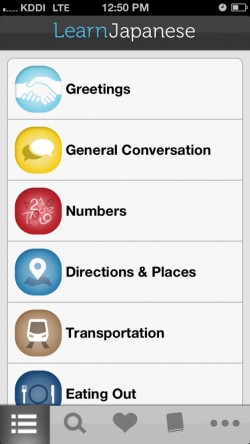 My best friend in learning Japanese so far has been my iPhone. It is always with me, and whenever I have a few spare minutes, I can study a little, whether that is while I am eating lunch or standing in line at the commissary. There are plenty of apps on the market, both free and for a fee. I have tried dozens of them and the following are my favorites … and they are all free!
My best friend in learning Japanese so far has been my iPhone. It is always with me, and whenever I have a few spare minutes, I can study a little, whether that is while I am eating lunch or standing in line at the commissary. There are plenty of apps on the market, both free and for a fee. I have tried dozens of them and the following are my favorites … and they are all free!
For phrases or “survival Japanese”:
If you just want to learn some basic phrases to help you get around, I recommend “Learn Japanese” by Codegent. It is divided into basic categories like, “Greetings,” “General Conversation,” and “Eating Out.” You can see the kanji for each word/phrase, see the pronunciation in romaji (that is, roman letters like you are reading now), and listen to the word/phrase at normal speed or slowed down.
Choose one phrase each day, and listen whenever you have a few seconds of free time. You’ll be surprised how much you pick up!
You can also save a list of favorites, which is surprisingly helpful. My personal recommendation is to ignore the kanji and just listen, listen, listen and then start repeating! It is quite user-friendly and doesn’t have any ads, either.
- The app called “Kana,” by The Japanese Page, is good for learning the kana initially. It might seem overwhelming at first, but fortunately the app divides the lessons into manageable chunks:
- First learn the 5 vowels
- Then learn the 5 “k” sounds
- Next the 5 “N” sounds
- … and so on.
- I think the review at the end of each lesson, which allows you to quiz yourself without any time limit, is the best feature of the app.
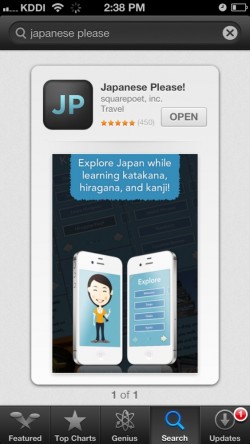
My Favorite…
“Japanese Please”, by Ron B. Yeh at Squarepoet, Inc., is by far my favorite app for learning basic Japanese writing. Once you have a basic understanding of the kana, this is wonderfully helpful!
The “Hirigana Find” and “Katakana Find” games are really helpful in retention and recall. They also have lists of “fun words” and “useful words” that use only the kana that you know, which is a great way to practice your knowledge.
Their section on numbers and basic kanji are also great. I highly recommend this app! It is also free of advertisements.
For Kanji
“Japanese Please” (see above). Seriously, guys, I really like this app. Ron B. Yeh will get you started with your basic kanji, which you can then use as the building blocks to expand your repertoire of kanji later, if you’d like. This app has only 100 kanji, but they are the 100 most-commonly used kanji, including numbers (which are easy, I promise!). I spent ten minutes with the kanji section of this a few days ago, and then had to run some errands. I noticed the few kanji that I had managed to pick up everywhere as I drove around.
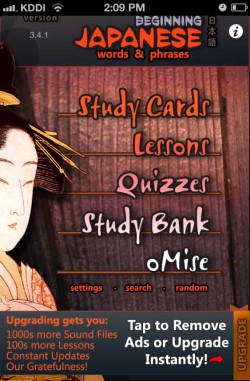 If you want more Kanji, you can download (for free) the extended version of “Kana” by the folks at The Japanese Page. It is called “JP Free” and has many, many kanji and phrases.
If you want more Kanji, you can download (for free) the extended version of “Kana” by the folks at The Japanese Page. It is called “JP Free” and has many, many kanji and phrases.
I like that it has the pronunciation written in kana, and that you can listen to the words. This is also great for building your vocabulary. The words are divided into practical categories like food, weather, and time.
For Linguaphiles
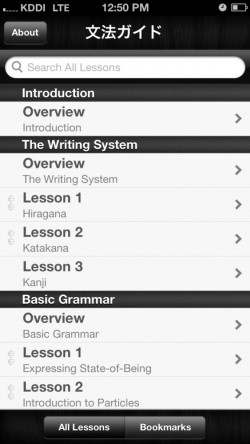 If you really like grammar and knowing all the rules, check out Tae Kim’s Guide to Learning Japanese. It is set up like a textbook and uses all the linguistic jargon that you could ever want: particles, state-of-being, transitive and intransitive verbs, and more! If this gives you nightmarish flashbacks to your high school foreign language class, then you will want to skip this one!
If you really like grammar and knowing all the rules, check out Tae Kim’s Guide to Learning Japanese. It is set up like a textbook and uses all the linguistic jargon that you could ever want: particles, state-of-being, transitive and intransitive verbs, and more! If this gives you nightmarish flashbacks to your high school foreign language class, then you will want to skip this one!
There you have it! As a final note, for best results I recommend downloading and using the apps in the order that they are listed in this article. And don’t skip the kana! I promise they are easier to learn than they seem, and it will really enrich your experience on the island to be able to read signs, menus, and posters at even a very basic level.
Do you use any other apps that you would recommend? Please share in the comments!


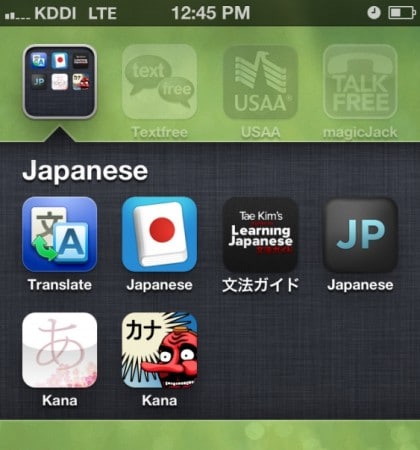

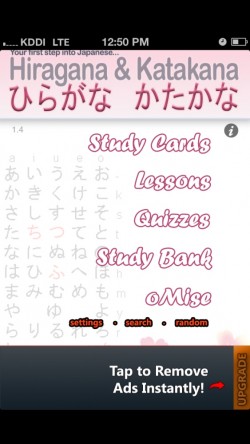
These are definitely something to check out! Arigatou!
The only other app I would add to the list is Human Japanese. It’s available for iPhone, Android, Mac, and PC. It’s a well-written, thorough, and fun introduction to the language.
Try Kanji LS and I also love making my own flashcards on quizlet. I also use JLPT study. My dictionary is my faithful and favorite imiwa. Imiwa is probably the only reason I have an iphone. How is your Japanese coming btw?
Thanks for this article. We will be moving next year and the one and only regret I have is never learning the Japanese language. My kids learned a little over the last 5 yrs in school culture class, but I personally just have a hard time remembering anything I learn. (I have tried.) I used a travel “Just Enough Japanese” book and a Google translator when randomly needed off base, however people generally don’t have the patience to stand around and wait for me to search through a language book to find the proper sentence to speak and when I do find it, half the time they still don’t understand what I am trying to say!
So I thank you for these very helpful app recommendations. I have a year left in Okinawa and would love to go home and say I was able to learn the language, even if only just enough to get by on. The visual apps may just be what I need to remember Japanese and or kanji.